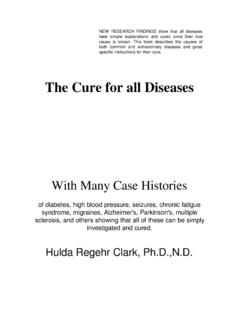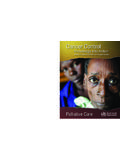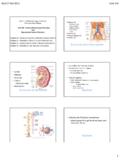Transcription of Human Mortality Data by Age and Disease - …
1 Human Mortality data by Age and Disease Developed countries have been keeping fairly careful birth and death records for hundreds of years partly because this data is central to calculations involved in life insurance, pensions, and annuities. The curve shown in Figure 1 shows 1999 Mortality i in the United States as a function of age. That is, the curve shows the fraction (equivalent to probability of death) of the people that age that died in 1999. The curve shows that the probability of dying approximately increases exponentially with age. The chance of dying during any given year is less than 1 percent until age sixty and rises to 30 percent at age ninety-seven. Figure 2 shows the same information displayed on a logarithmic vertical scale to make it easier to see the detail at the lower ages.
2 data for males (top curve) and females (bottom curve) has been added to the curve for the total population (middle curve). On this figure you can clearly see the infant and early childhood Mortality that declines to approximately age 4, and the childhood period where death rates are extremely low (< .02. percent). Then we see a sudden jump to another plateau between ages 18 and 30 where death rates are about .1 percent and where a dramatic difference between males and females is apparent. From age 30 onward, death rates nearly follow the exponential curve, doubling approximately every seven years. A 30 year old has a .1 percent chance of dying while 30; a 101-year-old has a 40 percent chance of dying before reaching 102. Biologists have long been curious as to why death rates level off for very old people.
3 Some actuaries use a simple exponential equation to approximate the probability of death as a function of age. This Gompertz Approximation (developed by Benjamin Gompertz 1779 1865) would appear as a straight line on figure 2 and is useful since the deviations between the actual curve and a straight line at very young and very old ages are relatively insignificant in an actuarial context. 1. Figure 3 again shows the same data as a survivor's curve based on the ages of people who died in 1999 and showing the fraction of the people left alive as a function of age. This curve shows that 90 percent of the people who died in 1999 were more than fifty- eight years old. Of those that died, 50 percent were more than seventy-eight years old. Aging and Disease It is obvious from the foregoing that we have been largely successful in conquering diseases that kill people more or less indiscriminately with regard to age or that strike children or young people preferentially.
4 Except for infant Mortality , diseases that kill 2. large numbers of people such as heart Disease , cancer, and stroke all have incidences that are very highly related to age. Here are the leading causes of death in the total population: Cause of Death (USA 2000 data ) Percent Heart Disease Cancer Cerebrovascular Diseases Lower Respiratory Disease (asthma, COPD) Accident Diabetes Influenza and Pneumonia Alzheimer's Disease Other Some age-related diseases involve processes that are plausibly a simple function of the passage of time. For example, some heart Disease involves buildup of deposits in blood vessels that would appear to gradually increase as time passed. Cancer is thought to involve multiple sequential mutations that would also be increasingly likely as time passed.
5 However, animals that have much shorter life spans also develop heart Disease and cancer. How is this explained? Also, there is evidence that even deposits of material causing heart Disease can increase or decline based on other factors such as cholesterol levels. Finally, a Disease (Werner's Syndrome) causing accelerated aging also causes accelerated incidence of heart Disease and at least some cancers. It is therefore clear that many age-related diseases are significantly caused by whatever causes aging. Putting it another way, a major treatment for aging could reasonably be expected to delay the average onset age of many or even most age-related diseases. Although a cure for many diseases has eluded us, major treatments have dramatically increased life spans of victims of diseases such as diabetes, cancer, heart Disease , and even AIDS.
6 We might think of a major treatment for aging as something that would eventually extend average life span by 50 percent or more. Such a development is no longer in the realm of science fiction. i National Center for Health Statistics. Vital Statistics of the United States, Volume II: Mortality , Part A. Washington, : Government Printing Office, various years. ( data obtained through the Human Mortality Database, ). Excerpted from the book: The Evolution of Aging ISBN: 0978870905. Azinet LLC 2009. 3.







